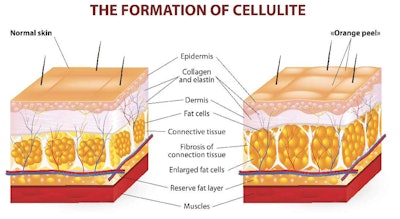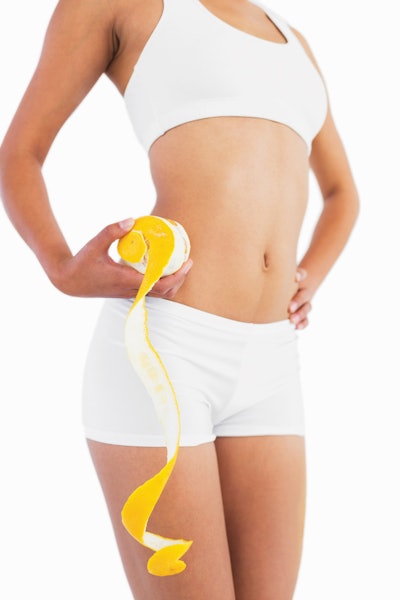 [Image: Getty Images]
[Image: Getty Images]The time is nigh to unpack swimsuits and shorts—and thus, to confront cellulite, the alltoo-visible skin surface rippling that occurs, to some degree, in 9 out of 10 women. Although cellulite treatment research is ongoing, there’s still no magic cure that can truly eliminate this complex problem. However, it is helpful for both clients and professionals to understand exactly how and why cellulite occurs, and what you can do about it. We turned to doctors, nurses and industry experts to make sure we could give you the latest science about the causes of, and best ways to address, “orange-peel syndrome.”
Why Mainly Women?
Cellulite forms when the fat in our tissue pushes or “herniates” through the inner layers of the skin. The migration of this fat results in numerous “pockets,” held in place by thick, fibrous bands, which create lumps that are visible on the surface. Nature predisposes females to cellulite for three main reasons.
RELATED: The Skin-Nourishing Properties of Coconut
The first is their tissue structure. Although cellulite is unrelated to overall body weight, it does tend to appear in fleshy areas such as the thighs, buttocks, abdomen and upper arms. “In women, these body parts have three layers of fat as opposed to one, so they’re the most susceptible to cellulite formation,” explains Flora Vergnolle, founder of Provence Cosmetics and Bioslimming. In men, the subcutaneous tissue is structured differently, so they’re much less likely to be affected.
The second reason centers around the ability of hormones to influence the rate and quantity of fat production. It’s no coincidence that women first develop cellulite after puberty. “Scientists postulate that the rapid deposition of fat during puberty leads to the herniation of fat through the skin,” notes Jessie Cheung, M.D., a dermatologist based in Willowbrook, Illinois. Moreover, cellulite formation tends to peak around another major hormonal phase for women: menopause.

Finally, genetics tend to determine whether a woman is going to have to tackle a predisposition to cellulite. After you explain all of this to your clients, they may respond, “Does this mean fighting cellulite is a lost cause?” Fortunately, the answer is no. Although we can’t change our nature-given physiology, there are numerous factors that contribute to the appearance and effects of cellulite. These can be addressed with a combination of lifestyle changes and treatments.
Contributing Factors
Wellness practitioners cite a multitude of causes to explain variances in the visibility and severity of cellulite. Some are not surprising: an increase in fat cell size and amount, for instance. Katherine Tomasso, national director of education for Yon-Ka Paris, describes cellulite as a “connective tissue disorder that develops from excessive fat in the hypodermis, plus inflammation.” According to Vergnolle, new research does indeed point to inflammation playing a role in the formation of cellulite. “Inflammation in the body, over time, contributes to the breakdown of collagen,” she says.
Lack of exercise is another factor. “Inactivity and weight gain often make cellulite more noticeable,” confirms Fayne Frey, M.D., a West Nyack, New York-based dermatologist. Low physical activity is a problem for two reasons: One, it allows muscles to lose tone, resulting in slackened skin that “showcases” cellulite; and two, “long periods of sitting reduce blood flow and lead to poor lymphatic drainage,” says Rhonda Nesbitt, RN aesthetic nurse specialist and esthetician at Skin Boutique in Birmingham, Michigan.
Melissa Morris, corporate educator for Pevonia, regards cellulite as a “toxic” body condition. “You must start at the source,” she reminds. “If your body is not eliminating waste properly, it becomes stuck in the colon and carried into connective tissues.” The lymphatic system plays an important role in removing cellular waste—lymph vessels work like the body’s vacuum cleaner, therefore a lymph massage and regular body brushing can stimulate those vessels.
RELATED: The Science Behind Stem Cells in Skin Care
Many wellness practitioners point to inadequate blood circulation as a likely contributor to cellulite because it occurs directly under the skin, an area that doesn’t normally get a lot of circulation. This, says Vergnolle, sets up a chain reaction. “You get less oxygen and nutrition to those areas, and that causes a decrease in collagen production,” she explains. “At this point, fat cells become larger; they begin protruding through the collagen and become the bumpy fat known as cellulite.” Without collagen fibers to keep tissue structure firm, “fat cells escape from tightly packed groups, move to the skin’s surface and enlarge to their full size,” explains Elaine Kroytor, rejuvenation specialist at the âme Spa & Wellness Collective at Turnberry Isle Miami.
Finally, there’s the question of diet. Tomasso advises that clients cut down on dairy, high-fat products, refi ned and processed foods, as well as those containing sweeteners, additives and unnecessary chemicals. Susan Ciminelli, a Los Angeles-based holistic skincare and nutrition expert, recommends a diet high in potassium—found in dark leafy greens, white beans, yogurt, bananas and avocados—as well as liver-cleansing milk thistle and dandelion supplements. “A toxic liver leads to excessive cellulite,” she explains. “Clients should minimize consumption of alcohol and manage stress to keep the liver functioning optimally.”

With so many identified potential causes, how does a spa practitioner work with clients who need help tackling their cellulite? You can start with education. Vergnolle believes the conversation should begin as soon as the client expresses a concern—which could be early. “We’re seeing teenage girls develop cellulite,” she says. However, sometimes that conversation comes much later, as Jennifer Masson, a nutritionist and esthetician based in Tampa, Florida, points out. “In older women, decreased estrogen from menopause impacts blood vessel circulation, and reduced blood-delivering nutrients and oxygen means less collagen production,” she explains. “So, fat cells get larger and appear as lumps and bumps.” The fact is, cellulite can appear at any age. “Yo-yo dieting and changes in metabolism can trigger cellulite formation, as can liposuction,” says Kroytor.
The consensus is that a multilayered approach is the only way to really make a dent in—well, the dents. “An effective cellulite program involves educating the client about cellulite’s causes and contributing factors—which include fatty foods, excess sugar, alcohol, insufficient water, circulation-restricting garments and stress—along with an internal detoxification regimen,” says Morris, emphasizing that the primary objective of cellulite treatment is to encourage elimination of trapped waste, rather than weight loss. “A comprehensive anti-cellulite plan may require partnering with local nutritionists, personal trainers, chiropractors or holistic doctors,” she says, and that requires commitment by guests to make lifestyle changes.
RELATED: Specialists Explain the Science Behind Peptides
A cellulite client who follows a complete plan will benefit most from the treatments you can off er her in the spa, which range from the traditional to the highly technical. All of them, however, are aimed at encouraging lymphatic drainage, removing excess fluid and impurities, boosting metabolism, encouraging circulation or some combination of these. “Massages performed manually with strong and quick movements, for instance, are effective in helping to drain excess fluid,” says Elizabeth Murchison, director of education at Guinot. Using a steam room or sauna draws out fluid and impurities via the pores. Detoxifying body wraps can produce immediately visible—albeit temporary—results, as can other wet body treatments. Ciminelli recommends dry-brushing clients, then preparing a soak with algae powder. “The liquid seaweed bath helps to reduce water retention, remove toxins and stimulate circulation,” she says.
Mechanical modalities such Endermologie and electrolymphatic therapy work to manipulate the tissues via rolling and suction actions. Sometimes massage is paired with the use of high-tech devices meant to penetrate tissues via enhanced temperatures, light or energy waves. Examples of this include infrared, cryotherapy, lipo laser treatments and radio frequency. “Tissue massage combined with diode laser therapy or infrared light and radio frequency, performed in a series of monthly treatments, produces results that typically last six months to a year,” reports Dr. Frey. It should be noted that any treatment that causes the skin to swell, such as heat-driven therapy, will temporarily reduce the appearance of cellulite.
The next step up in cellulite intervention is medical spalevel procedures such as mesotherapy injections, designed to “melt” fat in confined trouble spots. Nesbitt reports that Skin Boutique offers a Thermal Butt Lift that includes toning treatments followed by microneedling with the client’s own platelet-rich plasma (PRP) to stimulate collagen production. A new FDA-approved medical treatment for thighs and buttocks called Cellfina involves a physician using a “numbing wand” as local anesthesia and a needle-sized device to directly treat the underlying fibrous bands that tether the skin. Though the device is new, the process isn’t, says Dr. Cheung. “This technique is called subcision, and can be performed surgically or with a laser,” she explains. Subcision is done in a single treatment and results last up to three years.
In addition to following a lifestyle plan and receiving in-spa treatments, cellulite clients should be sent home with topical products formulated to increase blood fl ow to the skin, ideally used just after exercise when the metabolism is stimulated. Emphasizes Tomasso, “The best treatment products can multitask, metabolizing the skin while providing thermal and mild analgesic benefits, all to help support lipolysis and maintain the health and elasticity of tissues and capillaries.”
A successful anti-cellulite campaign requires time, patience and consistency from both client and practitioner. Even then, the best possible result is a reduction in the appearance of that orange-peel skin, because researchers still haven’t identified a treatment that may permanently reverse the effects. It is possible, however, to improve the condition enough so that clients will be able to face swimsuit season with their heads held high.
–by Katie O’Reilly











